
What does the UX future hold? - Here's the UX Design trends we expect to dominate 2023
December 21, 2022
When 252.000 new websites are created every day and there are seven million apps available across iOS and Android platforms is pretty clear that we’re living in a digitalisation era that shows no signs of slowing down.
As new technologies arise and evolve businesses need to understand how they can leverage them in order to make it in such an over-crowded and ever-competitive market.
User experience (UX) design is no longer an option but a must-have for businesses. Users behaviours and preferences are constantly changing so there’s a need to keep up with those changes to make sure you deliver a seamless experience. One that converts users into buying customers, and keeps them coming back.
Businesses must stay up to date on emerging user experience and interface trends so we’ve selected 7 top trends that are already making, and will certainly continue to make, an impact on website and app development:
- Mobile-first design
- Design for foldable
- Personalisation
- Scrollytelling
- Virtual and Augmented Realities
- AI-based tools
- Accessibility as a legal requirement
1. Mobile-First Design
These days, more than using a PC or tablet, people prefer using their mobile phones to browse the internet. In fact, the adoption of smartphones is gradually outgrowing the adoption of desktops and laptops. Mobile devices (excluding tablets) generated 58.99% of worldwide website traffic in the second quarter of 2022.
Companies need to shift their focus to mobile-first design which means creating web design for smartphones first, and then redesign them for other devices like desktops or tablets. This implies the adoption of responsive design practices, making sure a design scales correctly across different screen resolutions and devices.
When it comes to SEO (Search Engine Optimisation), Google’s search ranking algorithm also favours websites that prioritise an accessible mobile experience, which can help to increase online traffic.
In 2023, it’s estimated that 8% of all retail transactions will take place on a mobile device. That’s predicted to exceed 10% by 2025. When a big part of online purchases is conducted via mobile devices, creating a seamless experience that adapts to users ever-changing online shopping behaviour becomes incredibly important to convert visitors into paying customers.

Photo by Andrea Piacquadio from Pexels
2. Design for foldable
Foldable phones are gradually making their way into the global smartphone market. While until now Samsung has dominated the market with Z Fold, they are now facing some competition from the Chinese brand Honor who has just announced its new folding flagship, which will be available overseas.
Gartner estimates foldable phones to account to 30 million units by 2023, that’s 5% of high-end phones. With the growing demand for these devices, app development for foldable becomes more significant.
Google is already talking about hardware and UI considerations when adapting apps to foldable screens. In fact they have recently announced the optimisation of their workspace apps (Google Docs, Sheets and Slides) for tablets and foldable phones. They will also update more applications to work in these devices in the upcoming future.
Users will be expecting apps to present valuable features and functionalities so they can take the most out of their foldable device. For designers, while foldable screens open up a world of new opportunities for innovation and creativity, a multitude of design considerations also arise. For example:
- Multiple device postures — folded, unfolded and tabletop;
- Multitasking possibility — large screen foldables have a tablet-sized screen that facilitates multitasking in multi-window mode, where multiple apps can share the same screen simultaneously;
- Reachability — placement of UI elements when the device can be operated with one or two hands;
- Screen continuity — as users can toggle between folded and unfolded state, apps should provide a seamless experience when transitioning from one screen state to another.
.gif)
Adaptive layouts optimised for both folded and unfolded screens (Developers)
3. Personalisation
We considered it a trend for 2022, but the demand for personalisation shows no signs of slowing down. It has moved from a nice-to-have bonus to something essential for brands to stand out and make it in an highly competitive environment.
A recent study showed 73% of consumers expect companies to understand their unique needs and expectations. By designing personalised experiences brands can win customer loyalty and encourage users to keep coming back.
Not at the cost of personal data
According to Twilio, 63% of consumers are fine with personalisation — so long as brands are using their own data. Users are becoming more concerned with who has access to their data and how they use it. In alignment with that, Governments around the world are issuing data privacy laws and regulations, with harsh penalties to violators.
New privacy laws are restricting the use of third-party cookies. Brands need to leverage the use of first-party customer data — product preferences, shopping history, social media interaction, email address, and devices IDs. These allow users to receive a personalised experience without jeopardising their privacy.
AI-powered personalisation
Another way to guarantee a personalised user experience is taking advantage artificial intelligence (AI) and machine learning (ML). Brands like Netflix, McDonald’s, and Starbucks are already using it to tailor their products and services to the specific needs of users (read more about these examples in our UX Trends for 2022 article).
Amazon has recently opened their first-ever physical store — Amazon Style. They offer an elevated shopping experience which is built around personalisation. “Our machine learning algorithms produce tailored, real-time recommendations for each customer as they shop. As customers browse the store and scan items that catch their eye, we’ll recommend picks just for them. For an even more tailored experience, customers can share information like their style, fit, and other preferences to receive more refined recommendations.”
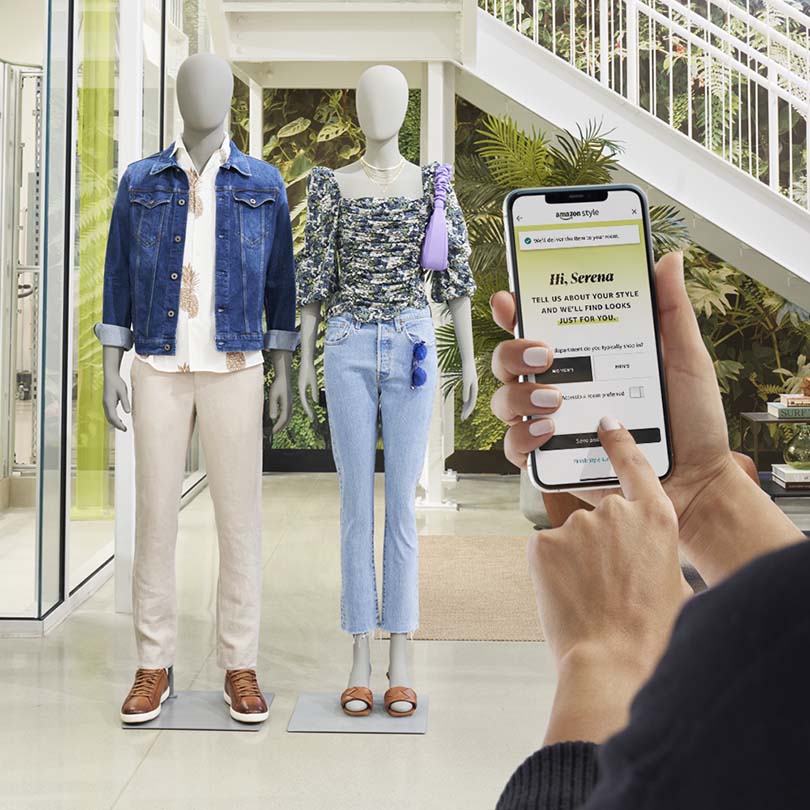
Source: Amazon Style
4. Scrollytelling
By mixing scrolling with storytelling you get scrollytelling, one of the biggest trends for 2023. It’s also called immersive scrolling and it allows designers to control what content they display to users, and how that content is shown, normally in a strategic and narrative manner.
Scrolling down a webpage triggers smooth animations and dynamic elements that communicate a story. When done right, besides improving the aesthetic appeal of a webpage, it can make users more engaged with the brand.
Scrollytelling is a very effective way to show off products. Apple and One Plus are good examples of that. Rather than being overloaded with product specs, users are presented with simple blocks of content that mix to-the-point headlines with dazzling visuals.

Iphone 14 Pro page in Apple’s website
Every Last Drop wants to alert people about the use of water in the UK. Huge blocks of text and some stock photos would make it boring and hard to digest. Instead they invite us to scroll down and tell us a story using playful illustrations.
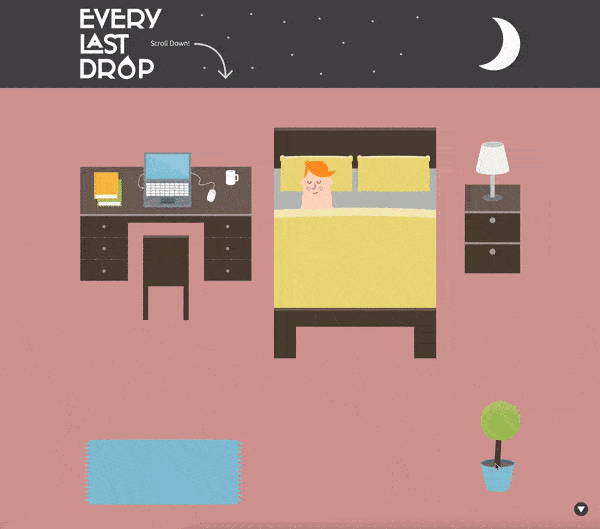
One last example is this biographical website about Stanley Kubrick which can’t certainly compete with a static Wikipedia page.
5. Virtual and Augmented Realities
What’s the difference between AR and VR?
AR — easily accessible by anyone with a smartphone. Uses a real-world setting to project virtual pictures and characters through the phone’s camera.
VR — requires a headset device. It’s completely virtual, producing a totally computer-generated simulation of an environment.
In 2022, Facebook rebranded itself as Meta and brought into the picture life in the Metaverse. Metaverse is a combination of different technological elements like virtual reality, augmented reality, and video, where users live within a digital universe. It has help VR gain popularity and we’ve been witnessing a hype into virtual worlds lately.
While the Metaverse platform, Horizon Worlds, reported 300.000 monthly active users in February 2022, it has now decrease for 200.000 monthly users. Most visitors generally don’t return after first month. All far from the predicted growth of more than half a million people.
While people might not exactly be keen on hanging out with friends and strangers with some VR glasses strapped to their face yet, the real world and the digital world are increasingly becoming more connected via VR and AR in many other ways across different industries, from education and retail to healthcare.
AR is now used in iOS’s Measure app to automatically measure a person’s height or the size of real objects. Apple Maps also uses augmented reality to provide immersive walking directions. You can raise your iPhone to scan buildings in the area, and Maps generates a highly accurate position to deliver detailed directions that can be viewed in the context of the real world. Virtual and augments realities are already widely used in the gaming industry, take Pokémon GO or PlayStation VR for example.
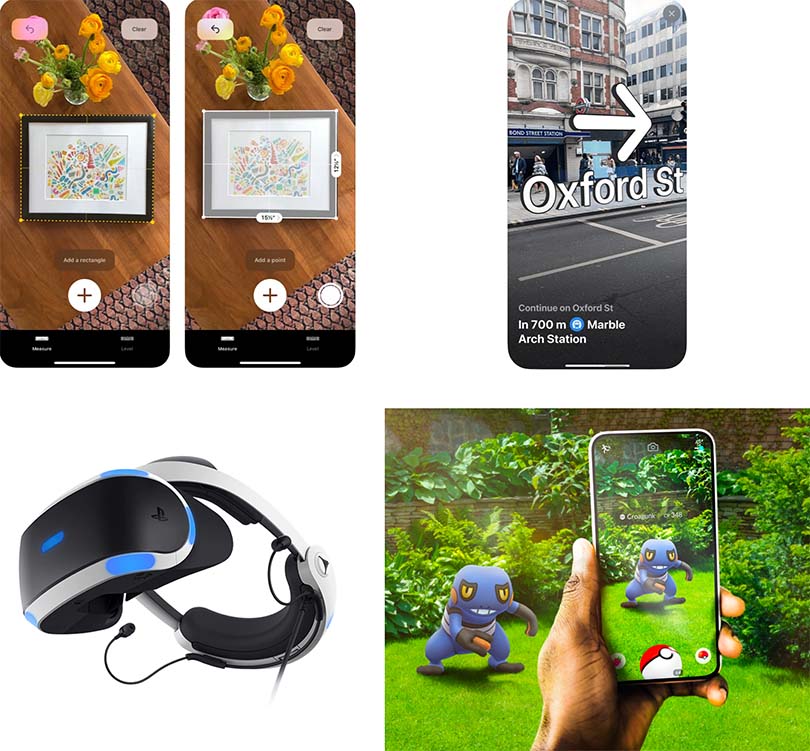
Measure App | Walking Directions in Apple Maps | PlayStation VR headset | Pokémon GO
In 2022 we saw the first-ever Virtual Reality Fashion Week with world-renowned brands like Tommy Hilfiger, Perry Ellis, Dolce & Gabbana, Ellie Saab, Estée Lauder and more.

Source: Dolce&Gabbana enters the Metaverse
E-commerce is one of the industries that has been taking advantage of AR. IKEA Place, for example, helps customers stage their own spaces with true-to-scale 3D models of their furniture. Amazon Fashion has recently partnered with Snap to let customers use augmented reality to try on different eyewear brands before making a purchase. Virtual Try-On Shoes, also by Amazon, let’s you visualise how shoes will look on your feet from every angle before you buy.
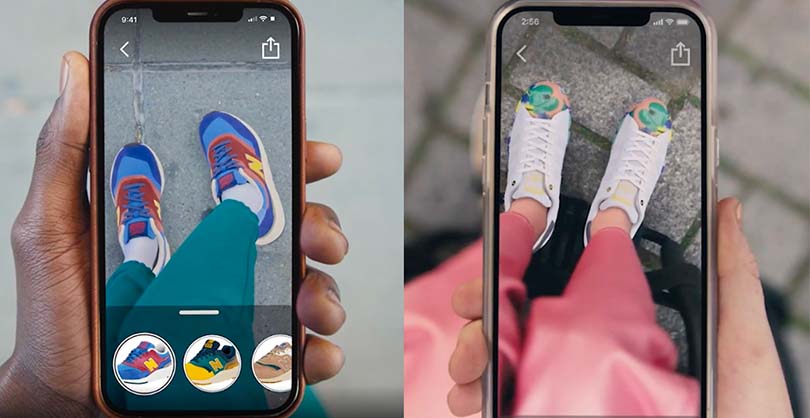
Source: Amazon
In Portugal, a bank is taking its first steps towards the Metaverse by launching their first virtual reality counter. By using a Meta Quest 2 headset, customers can access content about bank services.

Source: BPI
Brands have started to leverage AR and VR to create personalised and engaging experiences and they’ll most likely continue to go down that path. Consumers will be expecting that.
According to a recent study, interacting with products that have AR experiences leads to a 94% higher conversion rate. This happens because users can better access them and feel more connected with brands.
AR and VR technology is being developed and commercialised at a fast pace, they are becoming more accessible for everyone to adopt, and in the coming years their expected to be used more broadly.
As users are going beyond the screen interface and immersing themselves into a completely new virtual world, user interactions will have to be more realistic and mimic the actual environment.
6. AI-Based Tools
Artificial Intelligence is not a thing of an utopian future anymore. It’s gradually entering different spheres of our lives, and Design is no exception.
Next-level AI technologies are expected to affect the Design field in the years to come. Take Generative AI for example. It’s already making some design processes easier. Adobe is using it in Photoshop to generate new objects or variations of objects, and remove existing ones.

Generative AI in Adobe Photoshop
AI-powered online colour palette generators like Colormind and Khroma can help designers with unique colour schemes for their websites, apps and logos. They reduce the efforts in searching for colour using colour wheels.
DALL-E 2 promises to revolutionise image generation. All it takes is describing your idea through a text description. Then hit ‘generate’ and an original, realistic image is created for you. The software can expand images beyond what’s in the original canvas. It can add and remove elements while taking shadows, reflections, and textures into account, and it can can take an image and create different variations of it inspired by the original.
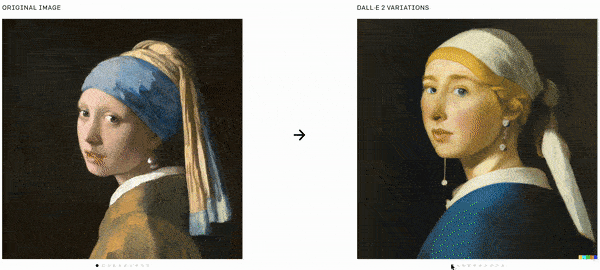
DALL-E 2 creating different variations of the painting “Girl with a Pearl Earring” by Johannes Vermeer
Last June, digital artist Karen X. Cheng created the first-ever AI-generated magazine cover, using DALL-E 2. When made available to the general public, DALL-E 2 will be able to generate an unlimited number of stock photos for design projects.
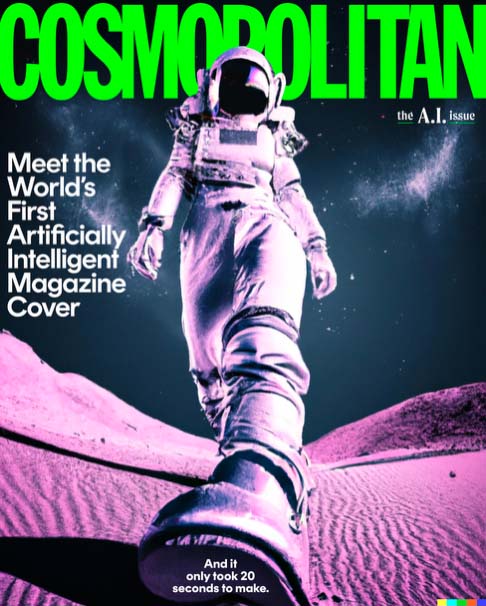
Cosmopolitan Cover, June 2022
When it comes to image enhancement a number of tools are already available to use — VanceAI, UpscalePics, Remini, Let’s Enhance. They allow you to upload old, low-quality photos and transform them into high-definition ones. Extremely helpful when you only have a low-quality image to work with and need to upscale it to use it in printed material.
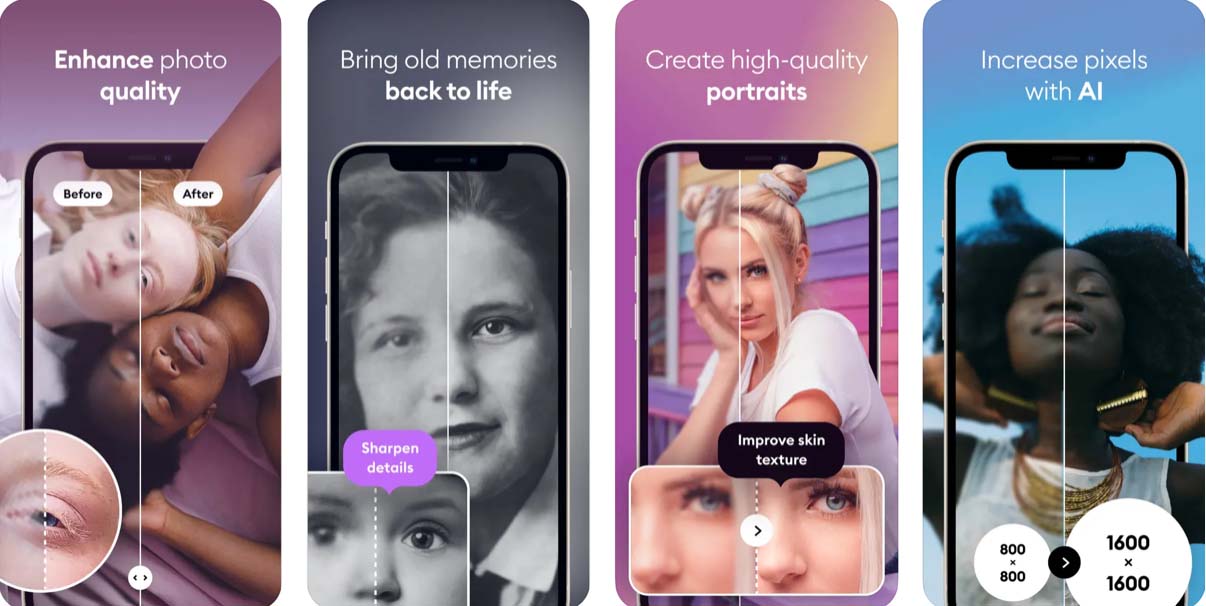
Remini also has an app version for iOS and Android
Removing a background from an image can be a real pain, specially with not so contrasting backgrounds. AI technology can be extremely helpful with that. It uses visual recognition to identify people and objects and remove background automatically. Some tools are already free to use — Erase.bg, Removebg and Clipping Magic, for example.

Image by Erase.bg
AI makes it now possible for brands to create virtual influencers. Luxury brand Prada used a virtual human model to be the face of their perfume “Candy”.

Image by Prada
AI face generation tools, like Face Generator or This Person Does Not Exist, can automatically create a face or you can configure the face by choosing skin colour, facial expression, hair length, etc.
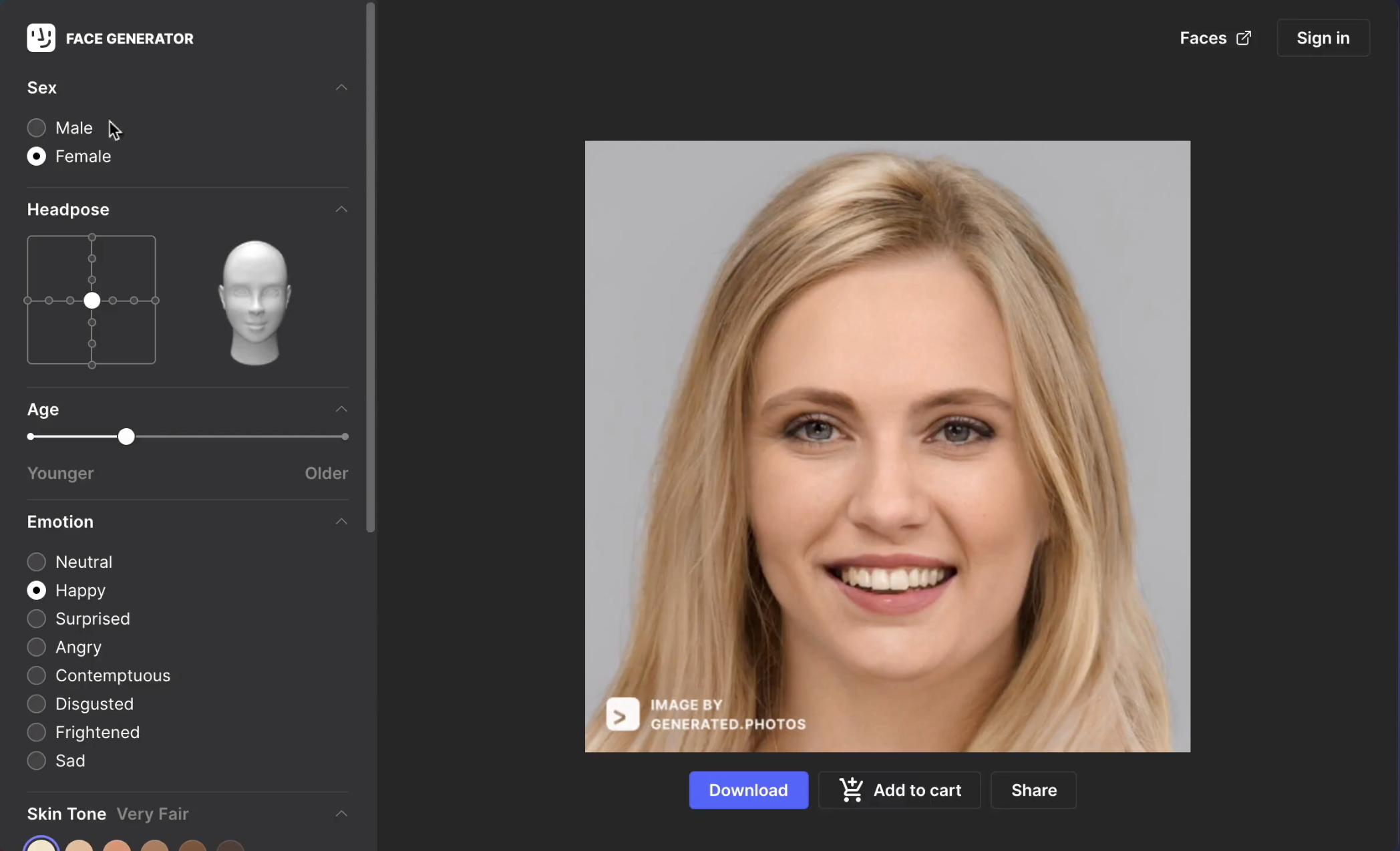
Source: Face Generator
Since we’re talking about faces and AI, NVIDIA Maxine takes real-time audio and video communications to a whole new level. It provides AI-powered, real-time 3D face tracking and body pose estimation based on a standard web camera feed. Its features include simulating eye contact by estimating and aligning gaze with the camera.

Source: NVIDIA
AI-based tools for image generation, image editing and illustration will be an important help for designers’ work. Time that was once spent on repetitive tasks like background removal, can now be used to explore more creative ideas.
7. Accessibility as a legal requirement
In 2022 all European Union member states had to transpose the European Accessibility Act into their national laws. That implies that by 2025, businesses are required to make their products and services accessible. These include ATMs, ticketing and check-in machines, passenger transport, banking services, e-commerce, etc. This means that 2023 is the year EU companies need to seriously worry about starting to apply accessibility standards and guidelines to their products and services, or risk breaking the law.
As other countries, such as the United States or the UK, have their own legal requirements regarding accessibility, designing for accessibility is not just something for European brands to care about. And when the WebAIM’s Accessibility Report detected failures in 96.8% of homepages we see how there’s still a long path to ensure websites are built with all users in mind and to make the web truly accessible for everyone.

Photo by cottonbro studio from Pexels
Accessible services with Xperienz
At Xperienz we want to help businesses offer accessible products and services to all their users. To simplify the presentation of the accessibility evaluation of a website, Xperienz has created the Accessibility Compliance App. It allows to check all accessibility errors found on each page of the website, including the type of error (content, design, code, navigation), the errors’ description and possible resolution, as well as the WCAG level and the resolution complexity classification.
Each error refers to a report page which displays the visual location of the error on the web page. To streamline the progression of the correction work by developers and designers, it is also possible to mark the correction of each page as completed.
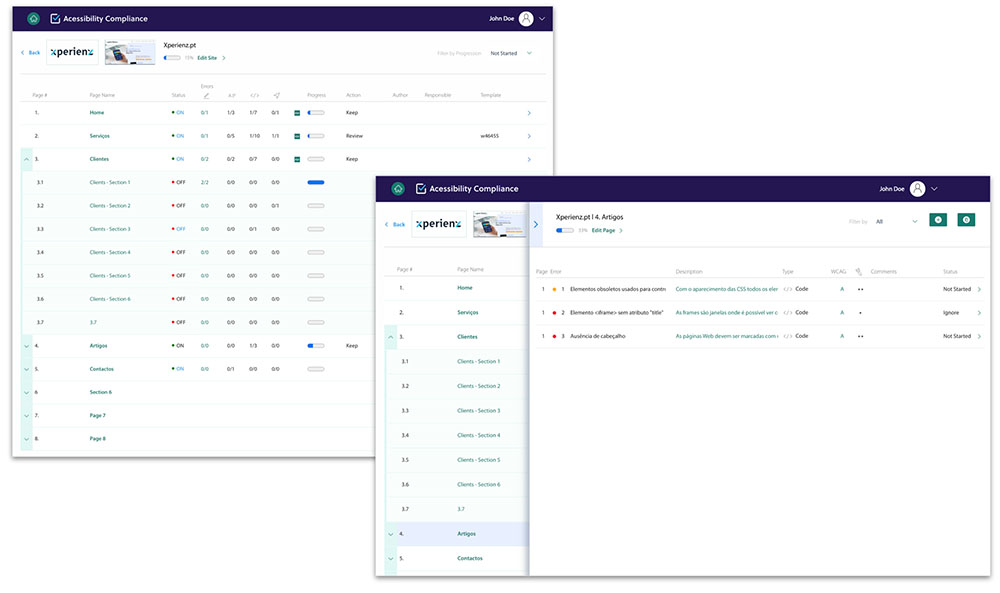
Accessibility Compliance App by Xperienz
...
Knowing the trendiest directions in web and mobile design for the years to come is easy. The real challenge is knowing which better suit your business and applying them correctly to the development of your web and mobile products. Are you up for the challenge?
Happy New Year! 🎉🥂🍾
Related Articles
-
Prompt-based — The birth of a new human-machine interaction model
The ways humans interact with technology has evolved significantly over the decades — and it’s still constantly evolving. The rise of Artificial Intelligence (AI) and natural language processing (NPL) has brought to light a new way of interaction — prompts.
-
A glimpse into the future — Here’s the UX design trends we expect to dominate 2024
Emerging technologies and tools constantly influence the way people use the Internet and interact with digital products. And as user behaviours and preferences evolve, designers must keep up with new tools and solutions to deliver interfaces and user experiences that cater the needs of an ever-demanding audience.
-
How can insurance companies make their digital products more accessible?
Millions of people who live with a disability struggle to access important information online because websites and apps are built with major content and technological barriers. And insurance websites are not an exception.
-
Barrier-free banking - From branches to mobile apps accessible for all
In the banking and financial industry, accessibility is about empowering everyone, including people with disabilities and the elderly, to enjoy bank's products, services and facilities, by making them convenient and easy to use.
-
Design for a better world - How working together and applying design approaches is improving people's lives
9 November is World Usability Day 2023. This year's theme is Collaboration and Cooperation, which intents to focus on how we can work together to create solutions, both globally and locally, to solve the world's biggest problems.
-
Be an Agent of Change - Check these resources to help you build more ethical designs
The role of today's designer goes far beyond simply creating beautiful interfaces and experiences. You can no longer design without considering the consequences of how what you're creating impacts individuals, society and the world.
-
E-commerce and Accessibility - Creating an inclusive online shopping experience
Now it’s the time for online stores to improve their website accessibility and ensure they offer an inclusive experience for everyone.
-
The future is today — How can we leverage AI to improve our UX Design work
AI has now become a big part of several areas of our lives, and UX Design is no exception. It’s actually becoming more and more applicable to the UX design process.
-
Conducting usability testing with people with disabilities
Drawing on our experience conducting usability tests with users with disabilities, we’re sharing a few things to take into account when planning and conducting research with people with disabilities and make sure everything goes smoothly and you can collect valuable insights.
-
Accessibility Compliance App - by Xperienz. A useful tool when fixing accessibility errors
To simplify the presentation of the accessibility evaluation of websites, Xperienz has created the Accessibility Compliance App. We start by doing a content inventory in which we collect all the pages of the site. Then we evaluate each page and list all the aspects that need to be fixed.
-
What does the UX future hold? - Here's the UX Design trends we expect to dominate 2023
Businesses must stay up to date on emerging user experience and interface trends so we've selected 7 top trends that are already making, and will certainly continue to make, an impact on website and app development.
-
Raising Awareness for Web Accessibility [Infographic] — International Day of Persons with Disabilities
Last December 3 we celebrated the International Day of Persons with Disabilities. To help promote a more accessible Web we’ve put together an easy-to-digest infographic about Web Accessibility.
-
Why hiring external UX services even when you have an in-house UX team?
Even if you have an in-house UX design team, there might be times when additional resources and professional know-how can be useful. Bringing in an external UX team might be exactly what you need for your company to excel in all projects.
-
Health and UX: when design has a life-saving potential
A good experience with healthcare technology and services, that is both useful, accessible and reliable, can make a huge different in improving peoples’ well-being, as well as the work of healthcare professionals.
-
Trust — Breaking or Building it Through Design
Trust is more valuable now than ever. 68% say trusting a brand they buy or use is more important today than in the past (Edelman, 2019). We live in an ever-growing digitalised world, where we increasingly interact and transact online. At the same time we constantly crave for trust-based interactions in digital environments. Questions like "Will the personal data I provide here be misused?", " Will my email be used to spam me incessantly?" or "Do I really want to share my bank details to a website I've never heard about?" have certainly come to our mind more than once.
-
Innovation Sprint — Exploring and validating a business direction in 2 to 4 weeks
During an Innovation Sprint, a new method created by Xperienz, the Sprint team joins efforts with the organisation team and in 2 weeks (minimum) they identify three strategic business directions, taking into account the organisation’s current state and structure. These innovative ideas are prototyped and tested and in the end the organisation will know the best path to follow.
-
Creating accessible digital experiences
Accessibility is of major importance for organisations who deliver web products and tools. Accessibility issues can affect not only a website’s usability for people who have disabilities but also for those who don’t. By offering accessible products, organisations will show they are inclusive, reach a wider market, be legally compliant, and offer a better user experience. For everyone.
-
"You're on Mute" - Lessons Learned After a Year of Conducting Remote User Research
After more than one year of engaging with users remotely, we want to reflect on the pitfalls of remote user research, share some of the lessons we learned and reflect on what’s going to be “the next normal” after Covid’s impact.
-
Quick & Dirty User Research
Tight timescales and budgets are no excuses to ditch user research altogether, specially when we all know it’s essential to make sure you deliver easy-to-use products. Quick and dirty research is a great way to get user insights fast and on a budget.
-
How bad metrics are hurting your business and your users’ experience
Businesses are deceiving themselves and annoying their customers as a consequence. They do so when they apply biased surveys only expecting to confirm what they want to hear.
-
UX Writing — Create better experiences with better content
Imagine a website or an app with no words. If it wasn’t for the logo, would you be able tell what this page is about? Would you know which button to click? Where navigation would take you? What you’re supposed to write in the search bar? No matter how good-looking an interface is, without words users will simply not be able to accomplish any tasks in it.
-
10 Bad User Research Practices You Will Want to Avoid
Some might think user research is as simple as watching people perform a few tasks on a website or asking them a few questions, but user research is definitely not walk in the park. Let’s go through some of the mistakes that can arise when planning and conducting research.
-
Responsive Illustrations
Can the same illustration be used the same way on a desktop screen, on a tablet or on a smartphone? How is it possible to make them look great on every screen without losing quality or the idea the brand is trying to convey?
-
UXLx Masters — Wrap-up
From 10 to 13 February attendees from 25 countries and 14 world-renowned UX experts joined online for 3 days of learning. The programme included 12 live masterclasses, 2 keynotes, 2 live podcasts, and more.
-
The Design Role in Digital Transformation
As the world keeps evolving and digital becomes more crucial to our everyday life, companies are feeling pressured to keep up and level up their game.
-
Remote UX Research — our selection of the best online tools to conduct it
As a company that focus on UX research and design, we gathered some of the best tools to conduct remote research and combined them, with our personal knowledge, in this article.
-
Why We Need Parametric UI Design Tools
In Design, parametric refers to a process based on algorithmic thinking that uses parameters and their interrelations to define a geometric form (which can be buttons, containers, panels, etc.).

